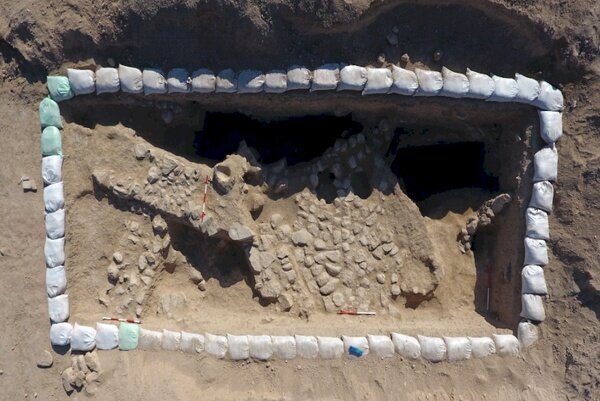Iran (IMNA) - Some historical objects and remnants of some architectural structures were discovered during the first archaeological season of Iron Age Tepe Gohareh, located four kilometers from Bisotun, western Kermanshah province, Ramin Chehri who leads the excavation said, ILNA reported on Tuesday.
These findings date back to three different time periods, probably to the Seleucid, early Parthian, and mid to late Parthian, he added.
In the middle of the Islamic period, however, a cemetery was established on the site, damaging the architectural layers from the late Parthian era, he mentioned.
It is hoped that the next season of excavation at Tepe Gohareh will reveal more about the Seleucid and Parthian ages of Bisotun and the Central Zagros region, he noted.
The Seleucid Empire was a Hellenistic state ruled by the Seleucid dynasty which existed from 312 BC to 63 BC; Seleucus I Nicator founded it following the division of the Macedonian Empire vastly expanded by Alexander the Great. Seleucus received Babylonia (321 BC) and from there expanded his dominions to include much of Alexander's near-eastern territories. At the height of its power, the Empire included central Anatolia, Persia, the Levant, Mesopotamia, and what is now Kuwait, Afghanistan, and parts of Pakistan and Turkmenistan.
Establishing a primary residence at Ctesiphon, on the Tigris River in southern Mesopotamia, Parthian kings ruled for nearly half a millennium and influenced politics from Asia Minor to northern India, until they were overthrown by Sasanian armies from southwest Iran in the early third century CE.
Parthian wealth obtained through lucrative trade networks resulted in substantial patronage of the arts, in particular, relief sculpture, statuary (large and small scale), architectural sculpture, metalwork, jewelry, and ceramics; coins with images of Parthian rulers form another important category of objects.
Bisotun is a patchwork of immense yet impressive life-size carvings depicting king Darius I and several other figures.
The area was on the ancient trade route linking the Iranian high plateau with Mesopotamia and contains remains from prehistoric times to the Median and Achaemenid eras.
The principal monument of this archaeological site is the bas-relief and cuneiform inscription ordered by Darius the Great shortly after he ascended to the throne of the Persian Empire in 521 BC.
The bas-relief portrays Darius holding a bow, as a sign of sovereignty and treading on the chest of a figure who lies on his back before him. According to legend, the figure represents Gaumata, the Median Magus, and pretender to the throne whose assassination led to Darius’s rise to power. This symbolic representation of the Achaemenid king in relation to his enemy reflects traditions in monumental bas-reliefs that date from ancient Egypt and the Middle East, and which were subsequently further developed during the Achaemenid and later empires.

Below and around the bas-reliefs, there are about 1,200 lines of inscriptions telling the story of the battles Darius waged in 521-520 BC against the governors who attempted to take apart the empire founded by Cyrus.
The inscription is written in three languages. The oldest is an Elamite text referring to legends describing the king and the rebellions. This is followed by a Babylonian version of similar legends. The last phase of the inscription is particularly important, as it is here that Darius introduced for the first time the Old Persian version of his res gestae (things done).
This is the only known monumental text of the Achaemenids to document the re-establishment of the empire by Darius I. It also bears witness to the interchange of influences in the development of monumental art and writing in the region of the Persian Empire. There are also remains from the Median period (8th to 7th centuries BC) as well as from the Achaemenid (6th to 4th centuries BC) and post-Achaemenid periods.
UNESCO has it that Bisotun bears outstanding testimony to the important interchange of human values on the development of monumental art and writing, reflecting ancient traditions in monumental bas-reliefs.
Once deciphered in the 19th century, it opened the door to previously unknown aspects of ancient civilizations. In that sense, the inscription at Bisotun has had a value for Assyriology comparable to that of the Rosetta Stone for Egyptology.
The massive site of Bisotun also features vestiges of Old Persian history, art and architecture, amongst them is the Statue of Hercules that was discovered around 1957.


Your Comment